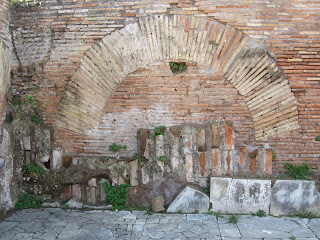Our Italian Thanksgiving Day dawned bright and sunny as we headed off for a day trip via bus to the coastal area. And like any tourists, we couldn’t resist a good photo op as we left the city.
This was the Imperial Palace we had seen when we toured the Palatine Hill, only from a different view. In front of the palace is the Circus Maximus, site of Ben Hur’s (and many others’) chariot races.
Our first destination was the ancient port town, Ostia Antica. Ostia dates from the fourth century B.C. and once it was taken over by Rome, served as a naval base and then a commercial port. At its peak, it was home to about 60,000 people. After Rome fell and the river changed its course, mud and silt buried the town. Even though there are impressive ruins to see, much is still underground and won’t be uncovered (The reason: theft! It is impossible to patrol this open-air museum and very easy to steal valuable mementoes. Churches face the same problem; art theft is common given the churches’ easy access and limited supervision). We were encouraged to imagine the various buildings covered in multi-colored marble and decorated with frescoes.
Ostia Antica ruins under Pines of Rome
One of the businesses in town was the Thermopolium; the ancient version of a tavern or snack bar. Frescoes, still visible, advertised food, drink, and music. One could order drinks at the restored bar (on left).
 |
| Looking down on the main street from the Grand Temple |
Along the main street Decumano Massimo, stood the town center (the Forum) with the Grand Temple or Capitolium and the Temple of Roma and Augustus facing each other. All that remains of the Augustus Temple is the stump of a column. The position of the Augustus Temple indicates that the emperor is equal in power to the gods.
 |
| Steam vents |
Community baths: where all classes of people socialized as well as sudsed. The reinforced arch in the wall added strength to the structure. The clay tiles are the steam vents.
The theater where public entertainment took place. Women and men sat in separate locations: women at the top. Bad actors were pelted with pieces of marble.
Masks that decorated the back of the stage
Square of the Guilds; mosaics advertised services available from each business.
Christian basilica dating from the second half of the 4th century A.D.
House with fresco. It is thought that buildings were originally five stories high.
End of glorious visit to Ostia Antica!
Since we were so close to the sea, we stopped for another photo op and an opportunity to dip our toes in the Mediterranean (actually Tyrrenhian) Sea. This was one of the few public docks near Rome. Most beach space is private and rents are high; a day at the beach is an expensive outing.
Our last stop of the day was a visit to the San Callisto Catacombs. No burials were allowed inside the city walls. Instead, Christians were buried outside along the Appian Way, the ancient Roman road that leads to Brindisi, a distance of about 400 miles on the east coast of Italy. As always, the original paving stones, like those in Ostia Antica (and Cambridge!) were jarring to walk on.
Catacombs were used for Christian burials. Pagans were cremated but Christians preferred to bury the body in anticipation of resurrection. Wealthy Christian landowners donated land for burial where tombs, more like shelf space, were dug many layers into the volcanic ground. Early popes and martyrs were also buried here but with the approach of the barbarians, their bones and relics were removed to churches in the city. There was no threat from authorities when bodies were buried and it is not true that Christians hid here in the catacombs. What was not allowed was to have Christian services anywhere including the catacombs. Frescoes of Christian symbols like the anchor (substitute for the cross), dove (soul), and fish abound.
We were not allowed to take pictures inside the catacombs but only of the outside area which was quite peaceful even though it was not far from the city.
Our Thanksgiving day ended with a restaurant meal of ravioli we shared with another couple from California and then a stroll along the Via XX Settembre not far from our hotel.















No comments:
Post a Comment